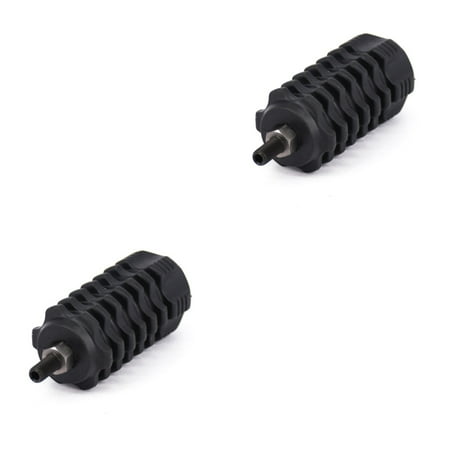Bow Stabilizer Purchasing Overview: Whatever You Required to Know Before You Purchase
Optimize Your Archery Precision With These Bow Stabilizer Techniques
In the realm of archery, attaining optimal accuracy is a pursuit that demands precise interest to information and method. One critical element that can substantially affect your efficiency is the appropriate use of bow stabilizers. These often-overlooked devices hold the prospective to raise your shooting efficiency to brand-new elevations, yet just if used properly. By checking out the nuanced methods of picking, setting up, and make improvements bow stabilizers, archers can unlock a world of accuracy that may have previously avoided them. Whether you are a seasoned archer wanting to refine your skills or a beginner eager to enhance your precision, understanding these bow stabilizer methods might be the key to striking your mark with unmatched uniformity.
Benefits of Using Bow Stabilizers
Making use of bow stabilizers can substantially enhance an archer's precision and overall efficiency by reducing bow torque and vibration. Bow torque, brought on by the unequal distribution of weight in the bow, can bring about disparities in shot placement. By affixing a bow stabilizer, the weight is redistributed, lowering the impacts of torque and helping the archer accomplish a more constant shot. Additionally, bow stabilizers moisten resonance, which not only boosts the comfort of capturing but additionally avoids the bow from leaping upon release, hence aiding in preserving correct objective.
Moreover, bow stabilizers can aid in holding the bow stable, particularly throughout gusty conditions or when shooting from longer ranges. The included weight at the front of the bow provides stability and balance, enabling the archer to concentrate on intending without the distraction of bow motion. Generally, the advantages of using bow stabilizers extend beyond just accuracy, improving the archer's experience and efficiency in different shooting circumstances.
Choosing the Right Bow Stabilizer
Selecting the suitable bow stabilizer is vital for maximizing your archery tools and boosting shooting efficiency. When choosing a bow stabilizer, there are numerous elements to take into consideration to guarantee you locate the appropriate suitable for your demands. Take into consideration the weight of the stabilizer. Heavier stabilizers can help decrease bow torque and absorb more resonance, bring about a steadier purpose. Lighter stabilizers use more maneuverability, which can be advantageous in certain shooting situations.

Lastly, think about the layout of the stabilizer. Some stabilizers come with adjustable weights or dampeners that permit you to customize the balance and feeling of your bow. Ultimately, choosing the ideal bow stabilizer entails finding a balance in between weight, product, layout, and length to enhance your shooting accuracy and general efficiency.
Correct Installation Techniques
To guarantee ideal efficiency and safety and security in archery, mastering proper setup methods for your bow stabilizer is necessary. The primary step in mounting a bow stabilizer is to identify the correct placement on your bow. Many stabilizers are affixed to the front of the riser, below the grip, to help counterbalance the weight of accessories such as sights and quivers. Ensure that the stabilizer is not interfering with other components or hindering your shooting form.
Following, firmly connect the stabilizer to the bow utilizing the suitable mounting equipment. It is crucial to tighten up the stabilizer well to stop any type of wobbling throughout shots. Some stabilizers include adjustable weights that can be added or gotten rid of to adjust the balance of your bow. Try out various weight arrangements to discover the optimal equilibrium that fits your shooting design.

Adjusting Stabilizer Weight and Length
After making sure the correct installation of your bow stabilizer, the next step includes readjusting the weight and size to maximize its efficiency in enhancing archery accuracy. The weight of the stabilizer plays a vital duty in decreasing bow movement during the shot cycle. Adding weight my blog to the stabilizer can help moisten vibrations and enhance security, causing even more exact and regular shots. On click this site the various other hand, lowering the weight can increase maneuverability, which is advantageous for situations requiring quick target acquisition.
When it pertains to stabilizer length, discovering the right balance is vital. A longer stabilizer can provide greater security by raising the range between the bow and the weight at the end of the stabilizer. This added range improves the supporting effect, specifically in gusty conditions or when shooting at longer ranges. On the other hand, a shorter stabilizer supplies extra maneuverability and may be favored by archers that value agility and quick movements throughout shooting.
Advanced Stabilizer Tuning Tips
Achieving optimum bow stability and accuracy in archery demands a nuanced strategy to advanced stabilizer adjusting. Advanced stabilizer tuning includes fine-tuning various elements to enhance the bow's equilibrium, reduce resonance, and boost general precision. One essential strategy is to try out various stabilizer configurations, including back-bar and side-bar configurations, to locate the optimal equilibrium between stability and ability to move for your shooting style. bow stabilizer. In addition, adjusting the angle and positioning of the stabilizer can have a considerable influence on how the bow responds upon launch.
One more important element of advanced stabilizer tuning is maximizing the damping properties of the stabilizer system. Discovering various materials for the stabilizer construction, such as carbon fiber or aluminum, can also influence the bow's performance by altering its weight distribution and tightness.
Conclusion
To conclude, maximizing archery precision can be accomplished through the correct choice, installation, and adjustment of bow stabilizers. By understanding the advantages of making use of stabilizers, selecting the right one, and adjust its weight and length, archers can boost their capturing precision. Using sophisticated adjusting methods can further boost stability and uniformity in arrowhead flight. Generally, incorporating bow stabilizers right into archery method can bring about enhanced efficiency and boosted accuracy.
Utilizing bow stabilizers can dramatically improve an archer's precision and overall performance by decreasing bow torque and vibration. Longer stabilizers supply greater stability and equilibrium, specifically for long-distance shooting, while shorter stabilizers use even more flexibility and are less complicated to maneuver in tight areas (bow stabilizer). Carbon fiber stabilizers are resilient and light-weight, while light weight aluminum stabilizers are robust and offer exceptional resonance wetting
A longer stabilizer can provide higher security by raising the range between the bow and the weight at the end of the stabilizer.Another important facet of advanced stabilizer adjusting is maximizing the damping homes of the stabilizer system.